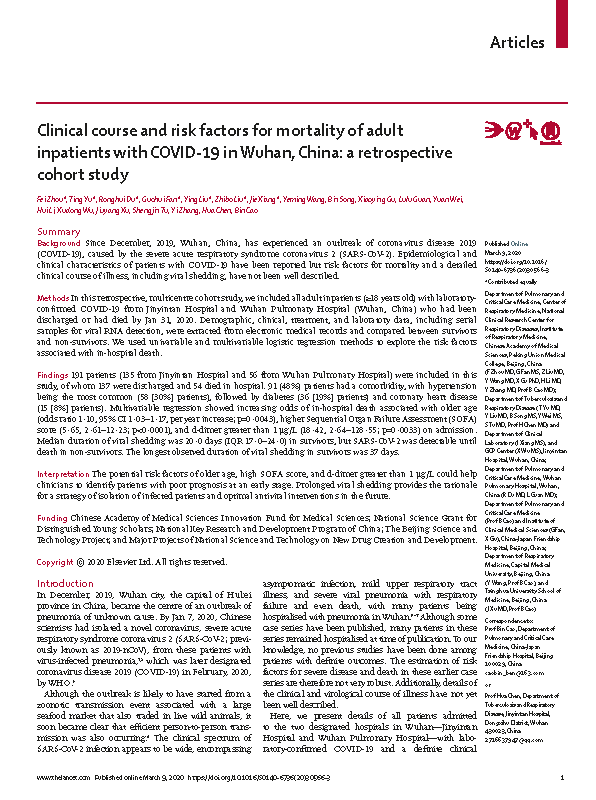09 Mar Clinical course and risk factors for mortality of adults in patients with COVID-19 in Wuhan, China: a retrospective cohort study
Fei Zhou, Ting Yu, Ronghui Du, Guohui Fan, Ying Liu, Zhibo Liu, Jie Xiang, Yeming Wang, Bin Song, Xiaoying Gu, Lulu Guan, Yuan Wei, Hui Li, Xudong Wu, Jiuyang Xu, Shengjin Tu, Yi Zhang , Hua Chen, Bin Cao

ABSTRACT
Background: Since December 2019, Wuhan, China has experienced an outbreak of coronavirus disease 2019 (COVID-19), caused by severe acute respiratory syndrome coronavirus 2 (SARS-CoV-2). The clinical features have been reported, but the epidemiology, risk factors, and detailed course of the disease, including virus clearance, have not been well described.
Methods: In this retrospective multicenter group study, we included all adult hospitalized patients (≥18 years) with laboratory confirmation for COVID-19 from Jinyintan Hospital and Wuhan Pulmonary Hospital (Wuhan, China) who had been discharged or died. before January 31, 2020.
Serial demographic, clinical, treatment, and laboratory data were included.
Viral RNA detection samples were extracted from electronic medical records and compared between survivors and non-survivors.
Univariate and multivariate logistic regression methods were used to explore risk factors associated with death in hospital.
Results: The study included 191 patients (135 from Jinyintan Hospital and 56 from Wuhan Pulmonary Hospital), of whom 137 were discharged and 54 died in hospital.
- 91 (48%) patients had comorbidity, the most common being hypertension (58 [30%] patients), followed by diabetes (36 [19%] patients) and coronary artery disease (15 [8%] patients).
- Multivariate regression showed:
- Increased odds of in-hospital death associated with older age (odds ratio 1 10, 95% CI 1 03–1 17, increase per year; p = 0 0043)
- Highest Sequential Organ Failure Assessment (SOFA) score (5 65, 2 61–12 23; p < 0 0001)
- d-dimer greater than 1 μg/L (18 42, 2 64–128 55; p = 0 0033) on admission
- The median duration of viral shedding was 20 0 days (IQR 17 0–24 0) in survivors, but SARS-CoV-2 was detectable until death in non-survivors:
- The longest observed duration of virus shedding in survivors was 37 days.
Interpretation: Potential risk factors such as advanced age, high SOFA score, and d-dimer greater than 1 μg/L could help clinicians to identify patients with a poor prognosis at an early stage. Prolonged viral shedding provides the rationale for a strategy of isolation of infected patients and optimal antiviral interventions in the future.


